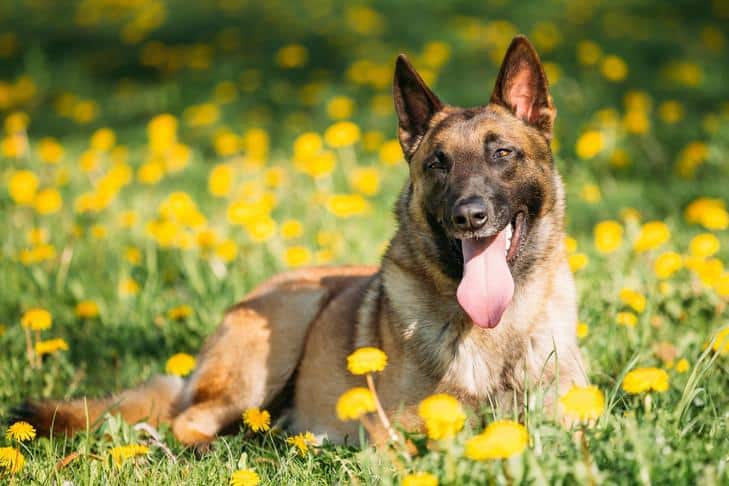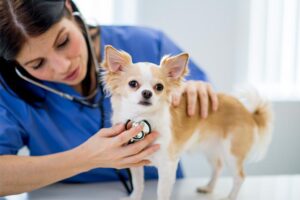Does your dog lunge and snap after bees on your daily walk or in your backyard? Unfortunately for our four-legged friends, our plant-pollinating friends can create a painful sting.
It’s even possible for dogs to eat and swallow flying bees, especially if their mouths are open while playing or chasing. Understanding why your dog is attracted to these flying creatures and how to stop this pesky behavior can help you tell bees to buzz off once and for all.
Why Do Dogs Want to Eat Bees?
Movement enthralls breeds like Labrador Retrievers, English Springer Spaniels, and Pointers. They naturally want to chase and capture things that move — sheep, cows, and even bees. Other dogs could be curious and possibly annoyed by a hovering bee buzzing around their ears. That buzz could be what triggers a reaction. Dogs may also chase after bees just because it’s fun!
Unfortunately, some dogs will develop a fear of flying creatures after being stung. This fear can actually spur them into chasing bees more vehemently than before. This strong emotional response causes them to be angry or unhappy when they run after the stinging bees.
On the flip side, some dogs develop phobias about bees. They may show panicked behavior by running away from bees, trembling uncontrollably, or even freeze at the sight of a bee — and this fear may extend to other flying insects as well.
Dogs can develop an obsessive-compulsive behavior, known as fly-snapping, even when there are no flying insects or bees around them. These dogs will snap at imaginary flies or hallucinations. Some breeds, including the Cavalier King Charles Spaniel and the Bernese Mountain Dog, are more likely to experience this disorder. Fly-snapping could also be health-related: it’s possible that the behavior stems from a digestive issue. If you think your dog is fly-snapping, talk to your veterinarian.

What to Do if Your Dog Ate a Bee
Thankfully, the only danger a bee or wasp poses to your dog is in response to a sting.
The first action you need to take is to figure out if your dog ate a bee, especially if you didn’t see them eat one. Check the outside of their snouts and lips. Look closely at the inside of their mouths, including the gums, tongue, and back of their throat.
If your dog suffers a sting, you need to remove any stinger seen (only honeybees leave stingers). Don’t pinch and pull the stinger out — that can force more venom into your dog. Do your best to gently scrape a bee stinger out. You can do this by laying a credit card against their skin and sliding it in one direction to coax the stinger out.
Your dog may yelp or whine in pain, which can be temporarily treated by gently laying ice on the affected area.
Reactions and Symptoms
Bees are venomous, not poisonous. That means that while the bee’s sting can hurt your dog, you need not worry about your dog being poisoned from digesting the bee.
The Purdue University College of Veterinary Medicine notes that bee stings cause mild swelling, reddening, and itching in most cases.
However, bee stings can lead to life-threatening allergic reactions. If you know your dog is allergic to bee stings, call your veterinarian immediately. Your vet may instruct you to give your dog a tablet of Benadryl. You’ll need to see your vet immediately so they can examine your pup and likely prescribe medicine. Do not give your dog any other medications without talking to your veterinarian first.
Bee stings can lead to swelling, difficulty breathing, lethargy, collapsing, coughing, vomiting, and diarrhea. If your dog is experiencing any of these symptoms, it’s time to call your veterinarian.
Unfortunately, bees can sting your dog’s insides. If a bee stings your dog’s tongue or throat, the swelling from the sting can block your dog’s airway. Swallowing a bee can also cause gastrointestinal problems. In worst-case scenarios, multiple stings can sometimes result in shock and damage to internal organs.
If you didn’t see your dog eat the bee but suspect they did, monitor them for any symptoms for a few days. If your dog eat a bee but don’t notice any symptoms, it’s likely the bee didn’t sting your dog and died. In any case, if you’re concerned, talk to your veterinarian!

How to Prevent Your Dog From Eating Bees
The most effective way to eliminate your dog’s bee-eating tendencies is to ensure bees can’t get anywhere near them.
Start discouraging bees from congregating around your home by removing any plants that attract bees. Some plants that attract bees are sunflowers, blackeyed susans, salvia, goldenrod, lavender, and roses. Alternatively, you could add plants that naturally repel pests like mint, rosemary, basil, and lavender.
Something as simple as changing walking routes can be enough to stop this behavior if your dog is only near bees during walks. Your dog can’t eat bees if they are nowhere near them!
You also need to teach your bee-chasing furry friend to remain calm around bees. Counter-conditioning training can help. The “leave it” command can help your dog leave these flying insects alone. Distracting your dog with a treat or a toy gives them something positive to pay attention to instead of bees.
In extreme cases, your dog may need to wear a muzzle.
If your dog’s behavior is fear-based, you need to consult a veterinarian or veterinary behaviorist. Dogs showing fear-related behaviors may need medication to address the problem.
Watching your dog chase after and snap at these buzzing bees can be scary and annoying. Implementing these practices can help your canine companion steer clear of these busy honey-producing workers.








